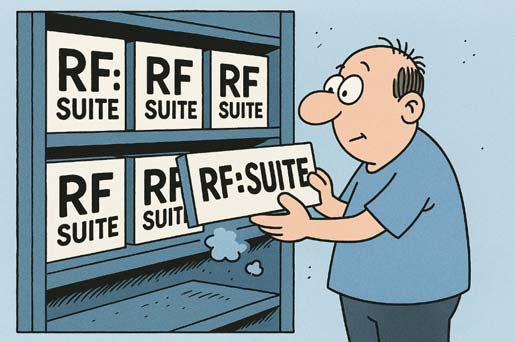Virtual commissioning has long been standard in mechanical and plant engineering. But what happens to the elaborately created digital twins after the project is completed? In practice, they all too often end up in a drawer. Yet there are huge untapped opportunities in these models – especially for training PLC programmers and plant operators.
The problem: virtual twins as one-time products
Virtual commissioning is now an established part of automation projects. Digital twins are set up to test control systems, validate processes and detect errors at an early stage – even before the real system is up and running. This saves time, reduces risks and prevents costly downtime.
But after successful commissioning, the same thing often happens: The model is archived, stored on a hard disk – and disappears. A huge amount of work, often lasting weeks or months, ends up in a digital archive.
The cause? Many companies simply lack a follow-up process for these models. They were built for a specific project goal – then the idea for the subsequent use is missing. The result: an enormous investment volume that doesn’t pay off. A digital model that was active for a few weeks – and then gathers dust.
The solution: RF::EdDi – from virtual commissioning to the training platform
The key question is: why stop at testing machines if you can also train people?
Digital twins offer a precise, realistic representation of the future system. Exactly what PLC programmers, plant operators and maintenance staff need to learn their tasks safely and efficiently – but without a real machine, without risk, without downtime.
Instead of building separate training systems or rigid didactic models, you can use what already exists: the Virtual commissioning model. With little additional effort, you can create a training environment that teaches exactly what counts in later operation – realistically, interactively and with practical relevance.
This is where RF::EdDi comes in. The software builds directly on the principles and technologies of virtual commissioning – but uses them not for the verification of control systems, but for the focused qualification of people.
RF::EdDi develops what was previously a pure engineering tool into a comprehensive training platform – in four steps:
How an EdDi training model is created The development of an EdDi model begins with the existing virtual commissioning model. This is not created from scratch, but rather adapted and expanded – for use in training.
1. polishing up the model
First, all functional elements from the original project are brought up to date. Areas that were “quickly made to fit” for virtual commissioning are thoroughly revised, stabilized and secured.
The model is given a technical polish, so to speak – it becomes more robust, more reliable and fully operational for the new purpose.
2. as simple as possible, as real as necessary
The next focus is on user guidance: navigation, control and interaction are designed in such a way that they can also be understood and operated by training participants – without prior knowledge of simulation or engineering.
The system is provided with additional visual details – from realistic sensors to ergonomically correct operating positions.
Important: Users should move and act in the digital twin in the same way as they would later on the real machine – including routing, button positions and visual axes.
3. faults as a training scenario
A major difference from the original virtual commissioning model is the integration of failure scenarios. Where previously only the “happy path” worked, error scenarios are now deliberately used:
– Sensor errors
– Incorrect operating sequence
– Safety violations
– Unplanned downtimes
These scenarios can be triggered and replayed, allowing operators and programmers to learn how to react in the event of an incident. Without risk, without stress.
4. eLearning mode: Interactive learning with real depth
The training model is completed by the integrated eLearning mode. This is no longer just about watching processes, but about actively going through them.
Practical examples:
– The system operator must set the correct clearings before automatic mode is available.
– The user must insert components correctly, observing safety distances and interlocks.
– Access to stations is only possible after authorisation – just like in a real system with light barriers or key switches.
This ensures a high degree of realism – and increases the confidence of everyone involved.
A practical example: From investment object to qualification platform
A well-known car manufacturer has already successfully followed this path.
A model of a highly automated conveyor and assembly system, originally created for virtual commissioning, was not discarded at the end of the project, as is usually the case, but further developed.
Today, this model is used with RF::EdDi to train over 50 PLC programmers per month – location-independent and scalable.
The effects are clearly measurable:
– Error rate reduced: new PLC programmers make fewer typical operational or logic errors.
– Training time is reduced: Employees are up and running faster.
– Reduced costs: Less real damage, less machine downtime, fewer correction loops.
– Scalable training: Training is now independent of location, time and availability of real systems.
What used to be a temporary project model is now a central part of securing skilled labour.
Why traditional training is no longer enough
Current practice in many companies often looks like this: Training on the real system when there is time – or on a simplified learning station when it has to be safe.
Both have their limits:
– Real systems are rarely available, expensive and not fault-tolerant.
– Didactic stations often represent reality only to a very limited extent.
RF::EdDi offers a middle way: as realistic as a real system, but as flexible as a digital model. And with full control, documentable progress and scalable implementation.
The bottom line: Your virtual models can do more than you think
Virtual commissioning is a powerful tool – but it is often seen only as a technical aid. But models are much more than that:
They are the perfect basis for sustainable, practical and risk-free training.
RF::EdDi turns a temporary project model into a permanent training solution. A cost factor becomes an efficiency driver. And a dusty asset becomes a tool for the future.
Do you have a VC model or would like to carry out a VC on your system? Then get in touch with us. We’ll show you how to turn it into a scalable training environment in just a few steps with RF::EdDi – for PLC programmers, plant operator, maintenance engineers and many more.





